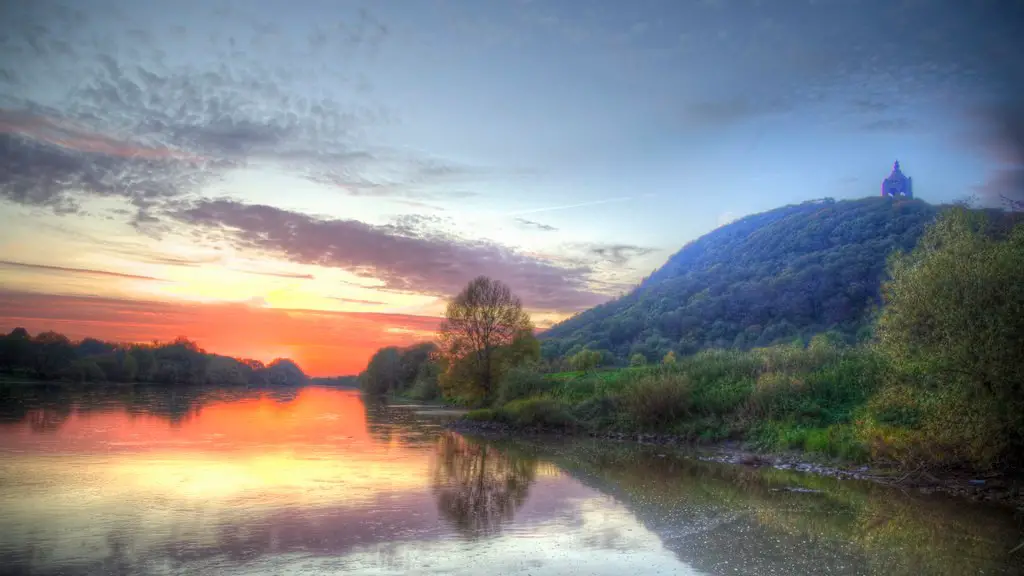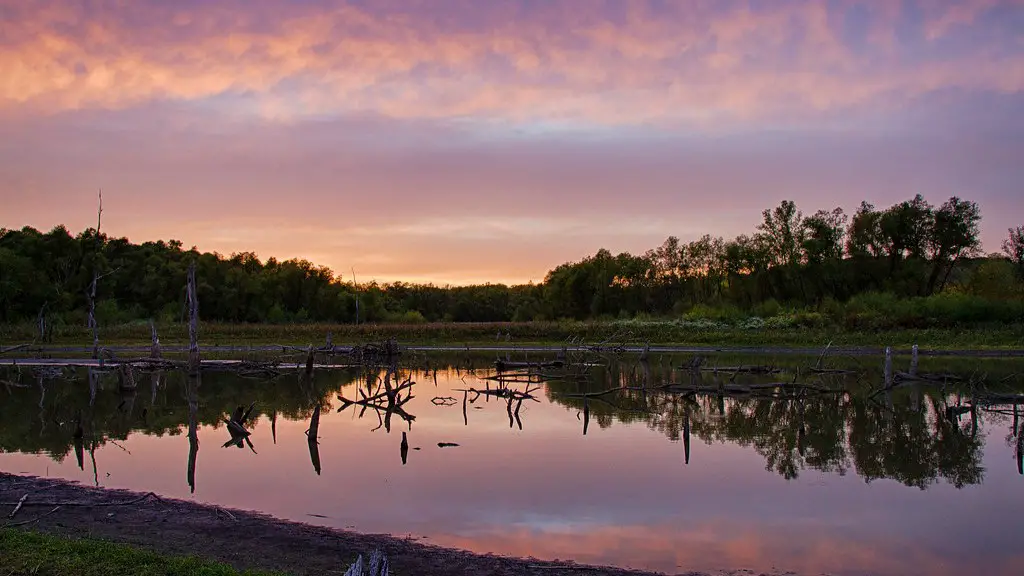Many people are aware that the Nile River is one of the most iconic rivers in the world; it is the longest river in the world and it offers a continuous lifeline to millions of people who live on its banks. But where exactly does this amazing river begin? Some may be surprised to learn that the Nile has two original sources and that it begins in two separate countries.
The majority of the Nile River is derived from the Blue Nile, which originates in Lake Tana, Ethiopia. This is the most important and most voluminous tributary of the river. It is believed that the Blue Nile is responsible for 80-90% of the water volume that flows into the Nile River. The White Nile is a less voluminous source, but still fairly substantial, and it is responsible for the remaining 10-20% of the river’s volume. This tributary originates from a small stream in the Great Lakes region of East-central Africa.
The two tributaries converge in northern Sudan and together, they form the Nile River that travels through the countries of South Sudan, Ethiopia, Democratic Republic of Congo, Uganda, Kenya, Tanzania, Rwanda and Burundi. It then passes to the Mediterranean through Egypt and ends up in the Nile Delta near the cities of Cairo and Alexandria.
The implication of the Nile’s sources is also an important part of the history of these African countries. These rivers, and their tributaries, have been instrumental in nourishing the lives of the people in the region and it has been heavily relied on for generations. In fact, the river is so significant to the history of the region, it is known as “the father of African rivers.”
The diversity of animals and plants found along the banks of the Nile have also contributed to its importance. The wetlands, designated protected areas, and the many man-made canals have made it an ideal place for wildlife and birds to live. There are over 300 species of birds known to occupy the wetlands, and a wide variety of wildlife including lions, hippos, crocodiles, and various species of fish and aquatic mammals.
The major source of the Nile is essential for the large cities near its mouth like Cairo, Egypt, where many people rely on it for both drinking water and irrigation water. Egypt’s population alone was estimated at around 100 million in 2018 and it is predicted to rise to around 145 million by the year 2025. Without this major source of the Nile, the population of Cairo and Alexandria would have little to no access to freshwater.
Impact of man on the river
The Nile River has been subject to human intervention in various ways. From drainage and irrigation canals, to dams, hydroelectric power stations and overfishing, humans have had a major impact on the river system’s shape and pollution levels. In recent years, water resource activities in the Nile Basin have had severe impacts on downstream areas due to decreased water flow.
The floods of the Nile also formed an integral part of the lives of people living in the region. These floods were beneficial in one sense because they brought fertile silt to the land surrounding the river, making it rich and fertile. On the other hand, they could also render large areas uninhabitable if the flooding was too severe. This regular flooding was regulated when the Aswan Dam was built during the 1960s, which allowed the flooding to be controlled by human intervention.
The Nile has also been subject to pollution due to increasing emissions of pesticides, fertilizers, and other industrial effluents released into the river. This has had an overall negative impact on the river’s water quality and on the underwater life. Waste management systems close to the river are often insufficient to properly deal with these pollutants, which then end up in the Nile.
The establishment of strict environmental policies and the adoption of sustainable practices has helped to reduce the effects of human activities on the river and subsequently, on the surrounding environment. More effort must be made, however, to protect the Nile and its surrounding environment from pollution, over-exploitation, and other negative impacts.
The importance of the Blue and White Nile
The origin of the Blue and White Nile are both places of immense importance and the symbols of Africa’s greatness. Aside from being significant sources of water, the importance of these two rivers have been reflected in the cultures, lifestyles, and economies of the countries in the basin. These two rivers have enabled millions of people to survive in regions that have little to no access to other sources of water.
The Nile provides an opportunity for socio-economic development in the region in the form of agriculture, transportation, and fishing. The Nile’s water resources are also essential for the production of hydroelectric power, which is used to fuel factories and other industries.
The Nile is also a great source of tourism, which brings in much needed economic boost for the countries in the basin. The many monuments and historical sites along the Nile are all reflection of this ancient river’s impact.
The origin of the Nile River is a combination of the Blue and White Nile, starting in the Great Lakes region of East-central Africa and Lake Tana, Ethiopia. This is the most important and voluminous tributary of the river, providing a lifeline for many people who live on its banks.
Taming the Nile with Dams
The presence of the Nile river has greatly shaped the geography of all the countries found along its course. The massive flow of the water has made it very susceptible and dangerous to floods, which can be especially devastating to those living close to the river.
The construction of dams for the purpose of controlling the floods began centuries ago. Ancient Egyptians, for example, had a sophisticated system of canals and dams that allowed them to regulate the river’s flow and exploit its resources. Over the centuries, as technology advanced, the size and scope of these man-made structures increased, providing better control over the floods.
Today, some of the largest and important dams along the Nile are the Aswan High Dam, Roseires Dam, and the Sennar Dam. Despite the benefits their presence brings, these dams have had a major impact on the environment surrounding them and further downstream, due to their inability to retain the excess silt that is usually brought by floods.
The dams have also heavily impacted the local fishing industries by destroying habitats and blocking the fish from migrating up and down the river. This has led to a decrease in fish populations and a decrease in the income for fishermen.
Environmental degradation
The increasing population in the region, combined with the effects of climate change and human activities, has led to serious environmental degradation in the basin of the Nile. The river’s natural resources, such as fish stocks, wildlife, and vegetation, have been heavily impacted by these conditions.
In Egypt, for example, the deforestation of the Nile River banks has led to an increase in soil erosion and an overall decrease in the catchment area of the river. This is mainly due to unsustainable farming practices such as the overuse of chemical fertilizers and pesticides, which have had a major impact on the aquatic life and the health of the river.
The situation has become so dire in some areas of the river basin, that the majority of the resources of the river, particularly in Egypt, are now considered too polluted for human consumption. The presence of nutrient-rich pollutants, such as nitrogen and phosphorus, in the water are disrupting the natural environment and lowering biodiversity.
In recent years, there have been several efforts towards restoring the health of the river and its environment by implementing regulations on industry, promoting effective land-use practices, and raising awareness among local communities. Despite this progress, much more needs to be done to ensure the protection of the Nile River and its ecosystems in the long term.
Challenges facing the Nile
The Nile River basin is facing a number of challenges with regards to water resources and the environment. As stated earlier, the over-exploitation of resources and the lack of proper waste management systems have led to environmental degradation in the region.
In addition, the countries in the Nile Basin are facing a conflict over the equitable sharing of its water resources. This is particularly evident in the building of dams; in the past, this has led to disputes between some countries in the basin as to who should benefit from the electricity provided by these dams.
Climate change is another major challenge for the countries along the Nile. Global warming is projected to reduce the river’s water level, which could lead to water scarcity, decreased agricultural yields, and food insecurity in the region. It could also lead to the endangering of the many species of wildlife and aquatic life found in the river.
To meet these challenges, the countries in the Nile Basin must work together to find common solutions and implement better policies to promote the equitable sharing of resources and the protection of the environment.
Conclusion
The Nile River is one of the most iconic rivers in the world and it is the lifeblood of millions of people who rely on it for their lives. The origin of the Nile lies in two separate sources – the Blue Nile which starts in Lake Tana, Ethiopia and the White Nile which starts in the Great Lakes region of East-central Africa. The Blue Nile is the major source, giving 80-90% of the river’s volume, with the White Nile providing the remaining 10-20%.
The significance of the Nile to the region has been instrumental in the development of its cultures and economies, providing a source of freshwater for many countries and a major source for electricity production. Unfortunately, the river and its environment have been subject to various forms of pollution and degradation due to human activities and climate change, which could have catastrophic effects if not addressed.





